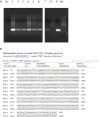Putative Role of Circulating Human Papillomavirus DNA in the Development of Primary Squamous Cell Carcinoma of the Middle Rectum: A Case Report
- PMID: 30847303
- PMCID: PMC6394246
- DOI: 10.3389/fonc.2019.00093
Putative Role of Circulating Human Papillomavirus DNA in the Development of Primary Squamous Cell Carcinoma of the Middle Rectum: A Case Report
Abstract
Here we present the case of a patient affected by rectal squamous cell carcinoma in which we demonstrated the presence of Human Papillomavirus (HPV) by a variety of techniques. Collectively, the virus was detected not only in the tumor but also in some regional lymph nodes and in non-neoplastic mucosa of the upper tract of large bowel. By contrast, it was not identifiable in its common sites of entry, namely oral and ano-genital region. We also found HPV DNA in the plasma-derived exosome. Next, by in vitro studies, we confirmed the capability of HPV DNA-positive exosomes, isolated from the supernatant of a HPV DNA positive cell line (CaSki), to transfer its DNA to human colon cancer and normal cell lines. In the stroma nearby the tumor mass we were able to demonstrate the presence of virus DNA in the stromal compartment, supporting its potential to be transferred from epithelial cells to the stromal ones. Thus, this case report favors the notion that human papillomavirus DNA can be vehiculated by exosomes in the blood of neoplastic patients and that it can be transferred, at least in vitro, to normal and neoplastic cells. Furthermore, we showed the presence of viral DNA and RNA in pluripotent stem cells of non-tumor tissue, suggesting that after viral integration (as demonstrated by p16 and RNA in situ hybridization positivity), stem cells might have been activated into cancer stem cells inducing neoplastic transformation of normal tissue through the inactivation of p53, p21, and Rb. It is conceivable that the virus has elicited its oncogenic effect in this specific site and not elsewhere, despite its wide anatomical distribution in the patient, for a local condition of immune suppression, as demonstrated by the increase of T-regulatory (CD4/CD25/FOXP3 positive) and T-exhausted (CD8/PD-1positive) lymphocytes and the M2 polarization (high CD163/CD68 ratio) of macrophages in the neoplastic microenvironment. It is noteworthy that our findings depicted a static picture of a long-lasting dynamic process that might evolve in the development of tumors in other anatomical sites.
Keywords: cancer; circulating HPV; exosomes; immune evasion; middle rectum.
Figures





References
-
- Ambrosio MR, Onorati M, Rocca BJ, Santopietro R. Vulvar cancer and HPV infection: analysis of 22 cases. Pathologica (2008) 100:405–7. - PubMed
-
- Jeannot E, Becette V, Campitelli M, Calméjane MA, Lappartient E, Ruff E, et al. . Circulating human papillomavirus DNA detected using droplet digital PCR in the serum of patients diagnosed with early stage human papillomavirus-associated invasive carcinoma. J Pathol Clin Res. (2016) 2:201–9. 10.1002/cjp2.47 - DOI - PMC - PubMed
Publication types
LinkOut - more resources
Full Text Sources
Research Materials
Miscellaneous

